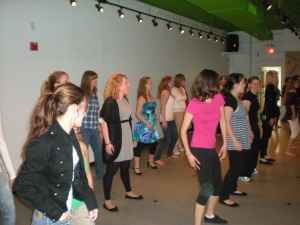Au Pairs work hard all week long. They provide childcare for their Host Families for up to 10 hours a day and 45 hours a week. They have fun with the children; taking them to the park, playing games, reading, helping with homework, driving to activities and so much more. So when the work week is over, Au Pairs love to take a break and relax.
On Friday, April 16 three Au Pair in America clusters from the western suburbs gathered at Expression Dance Studio in Westmont for: “Au Pair Dance Night Out.” They were joined by their local Community Counselors Maria, Pat and Pam, and one very brave set of Au Pair parents for some dance lessons and a whole lot of fun. The au pairs learned a few “smooth latin moves” and how to have fun, and look good out on the dance floor. One Au Pair commented: “Dance Night was so much fun, we should do this again very soon.”



